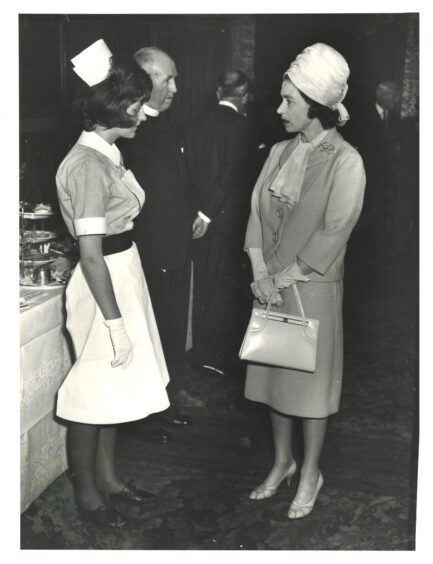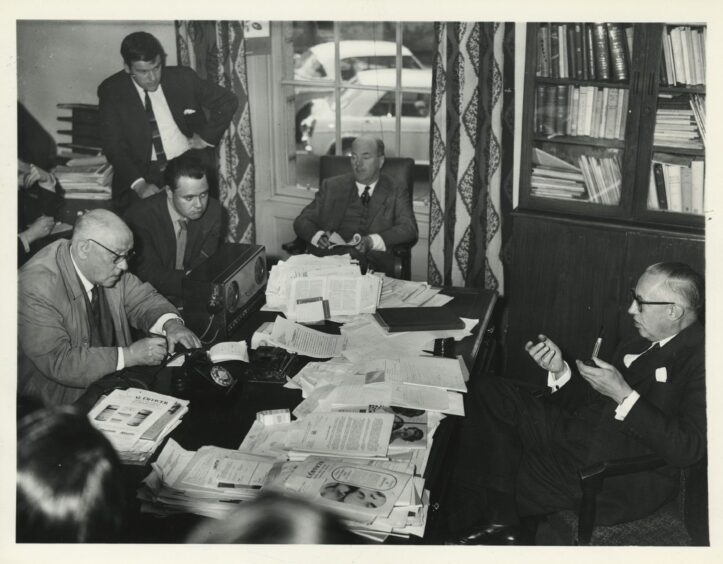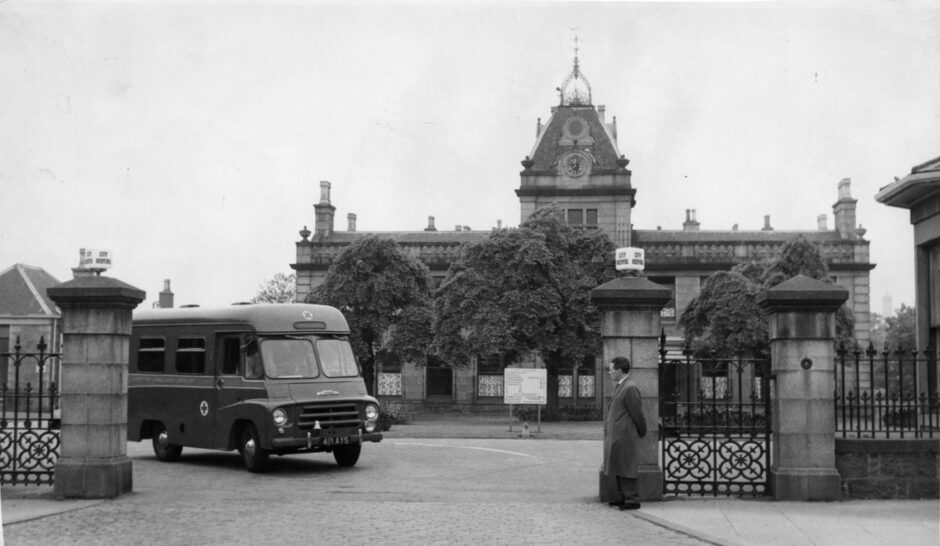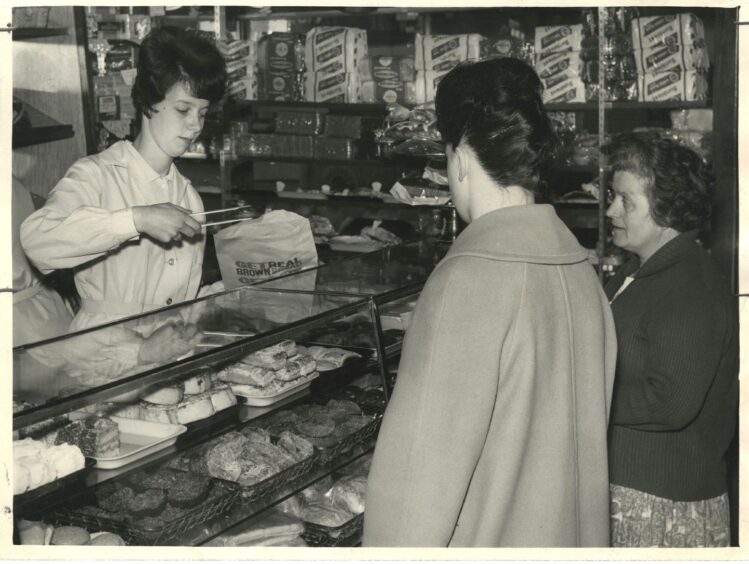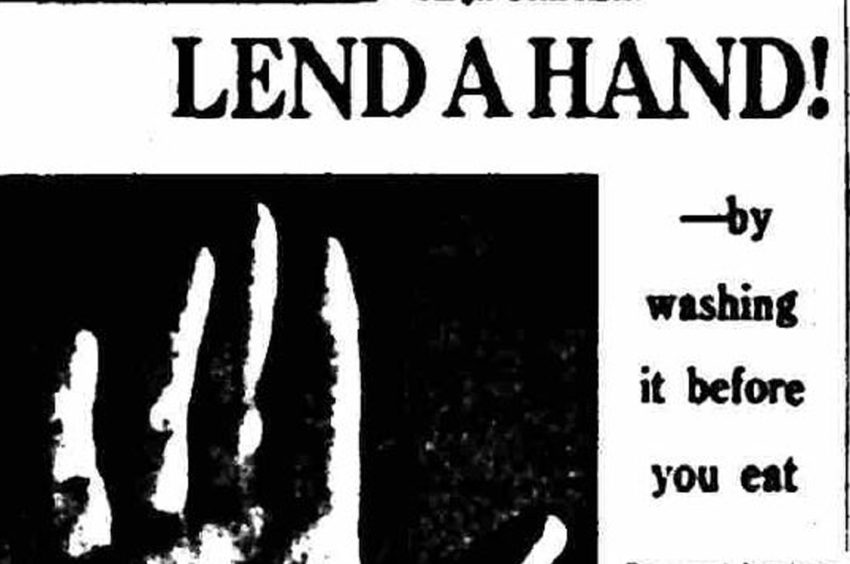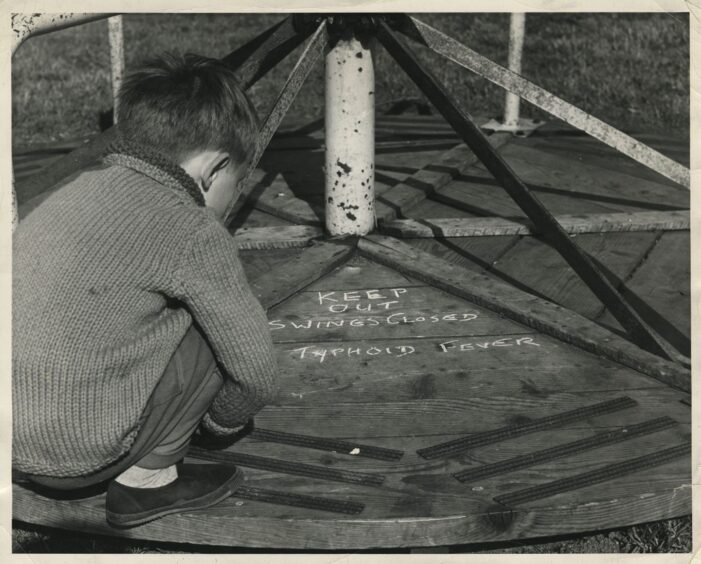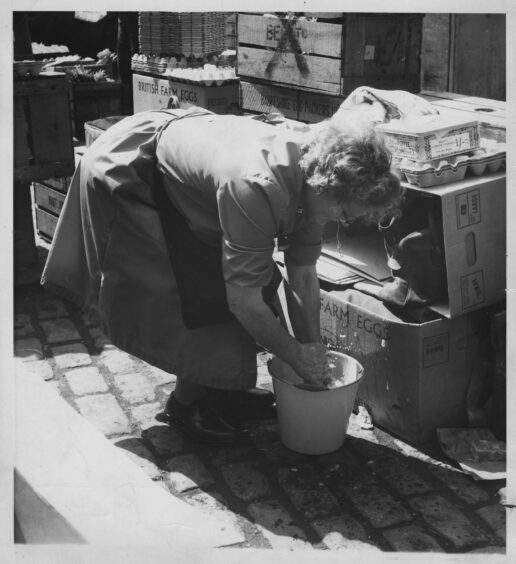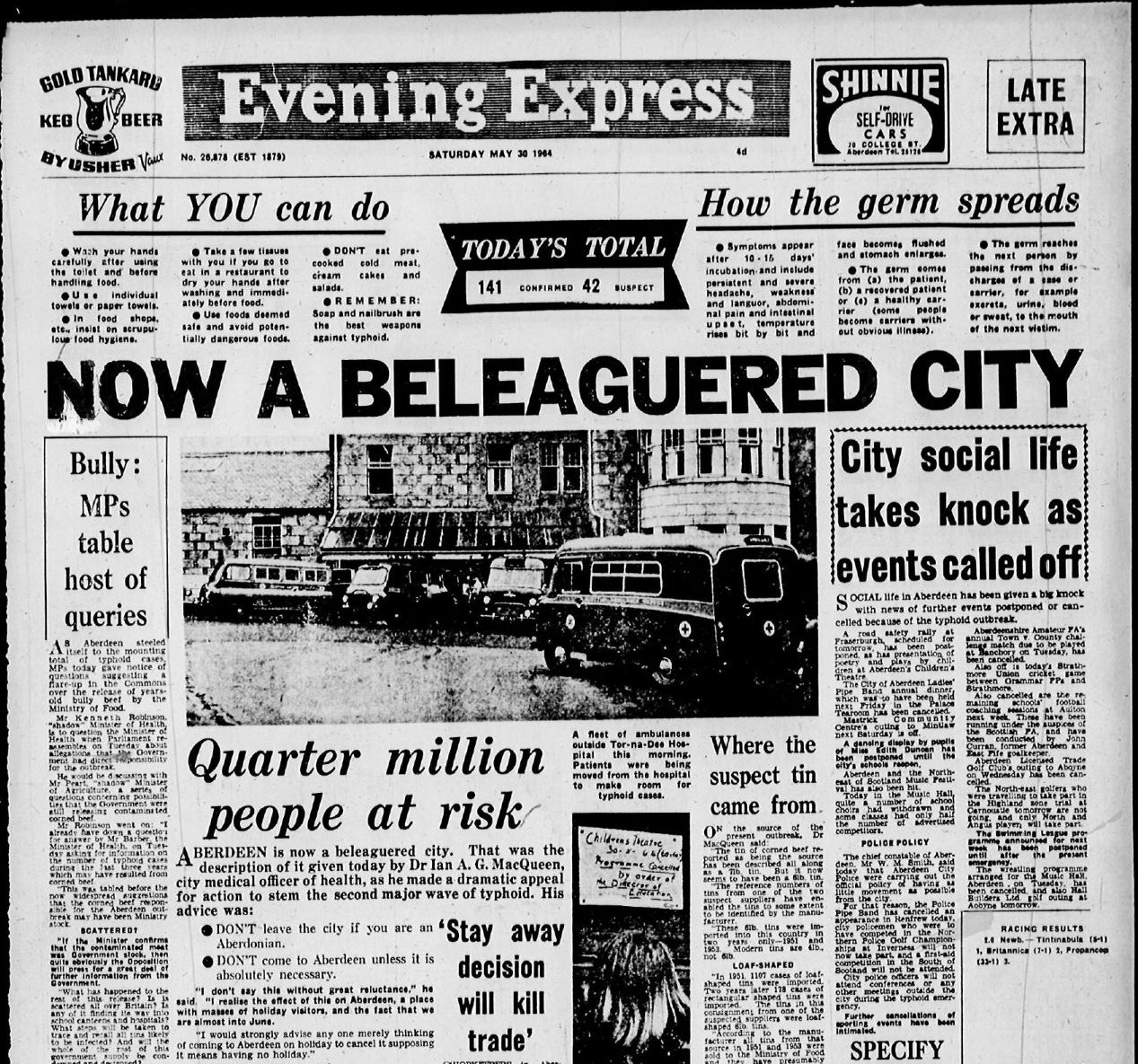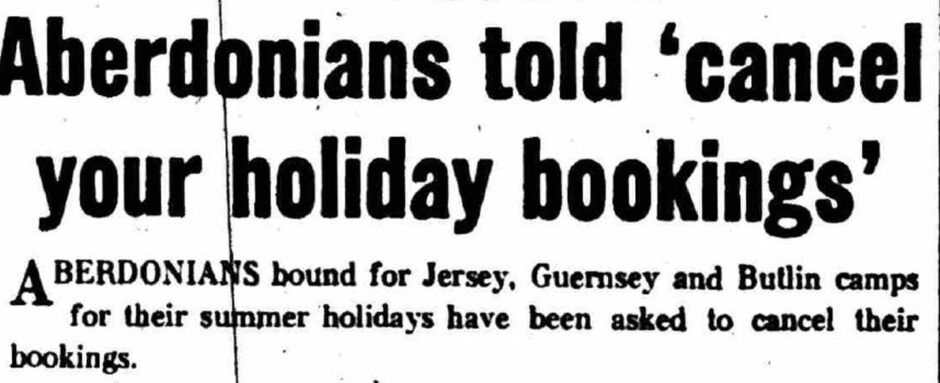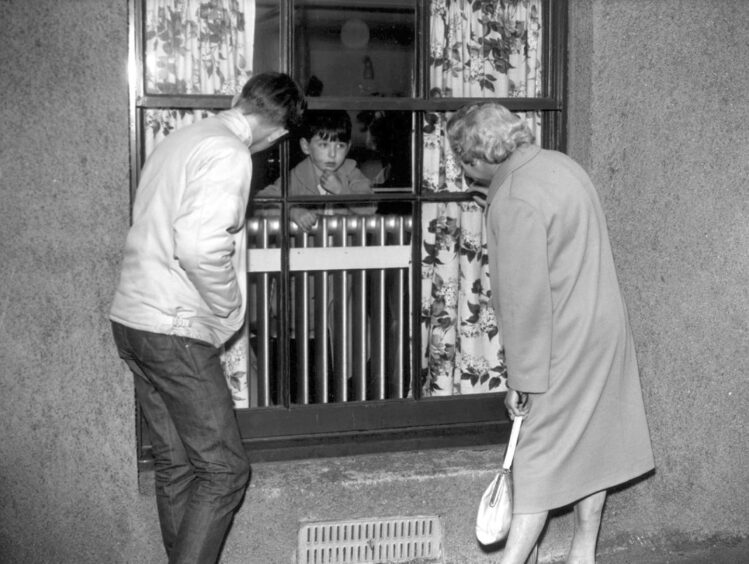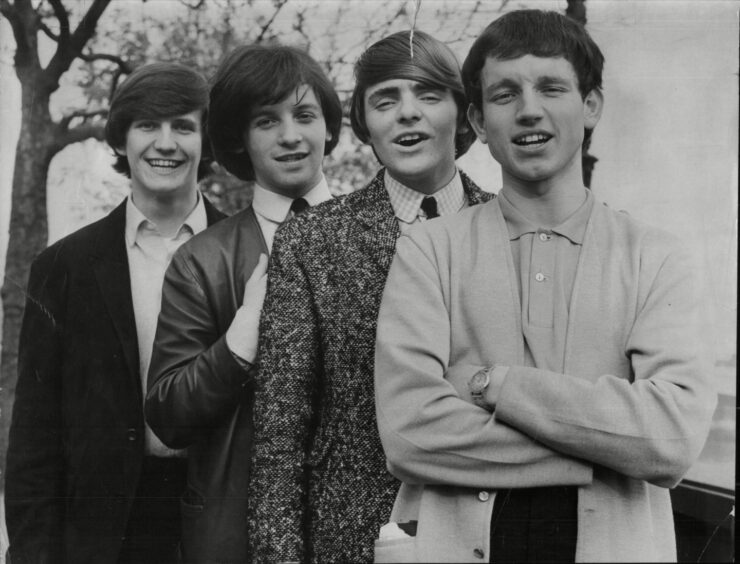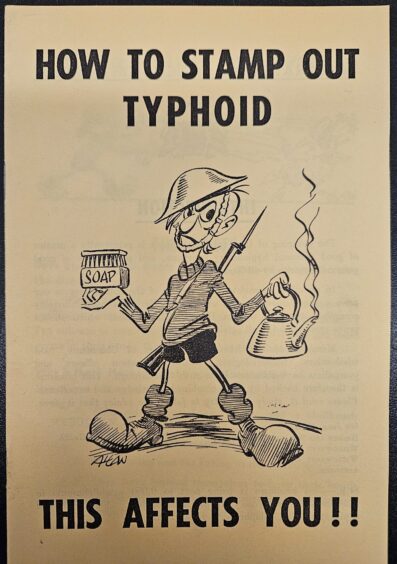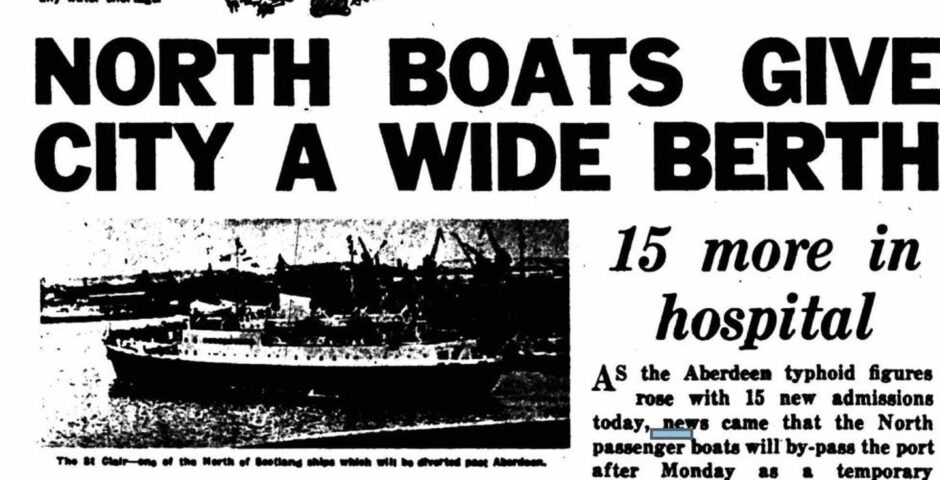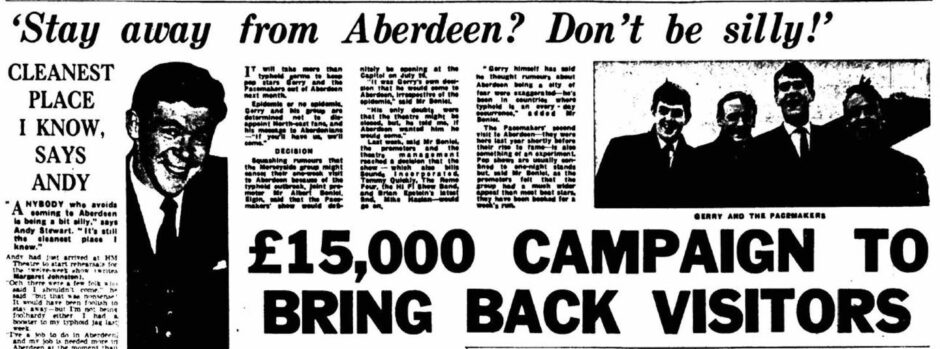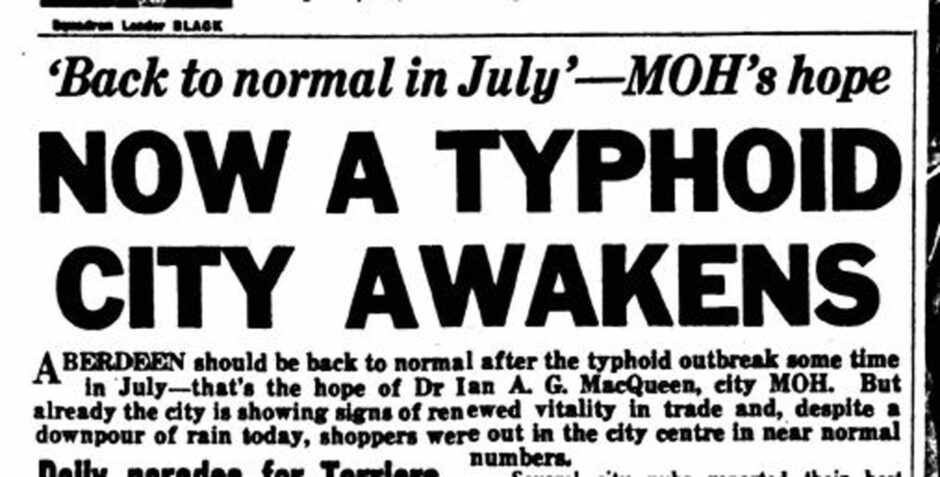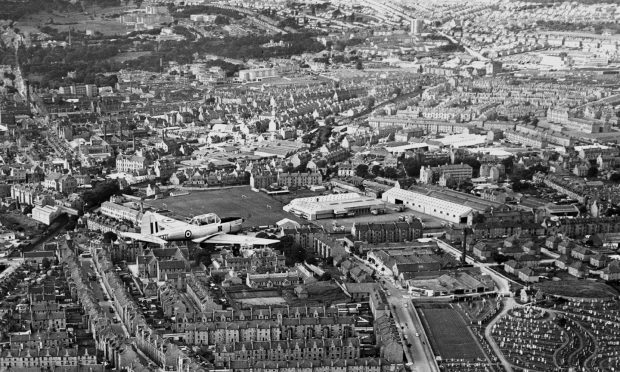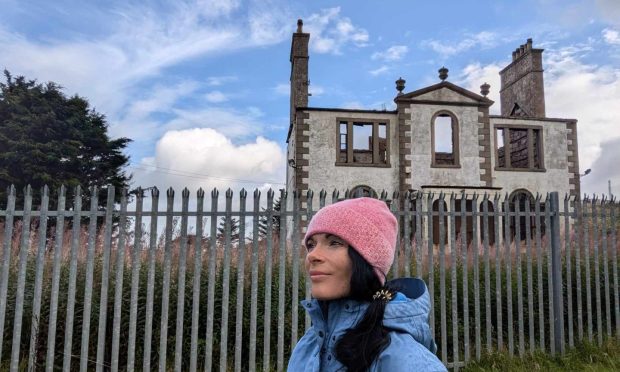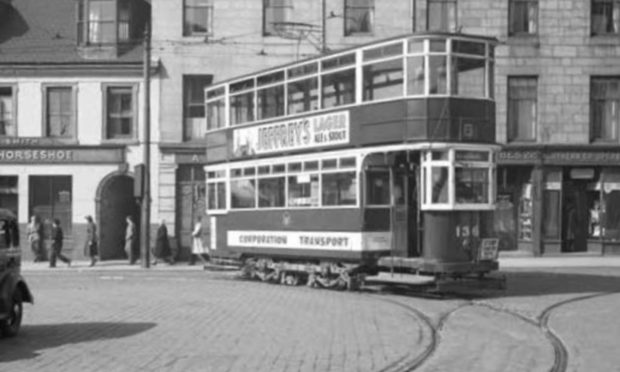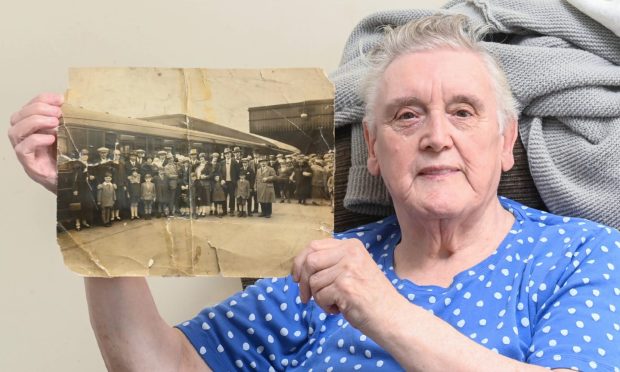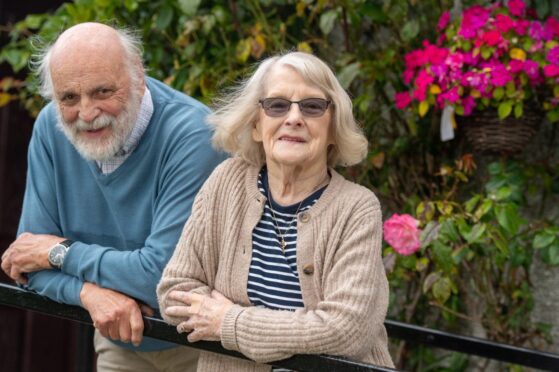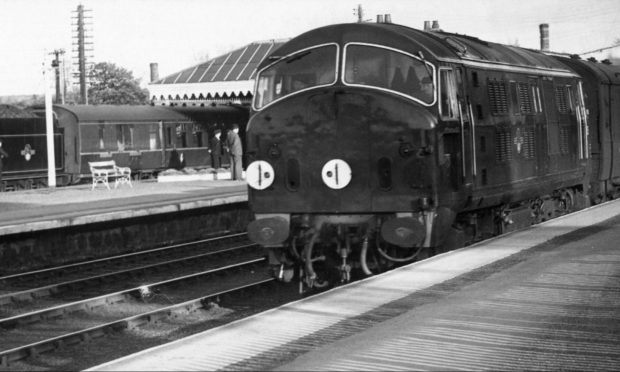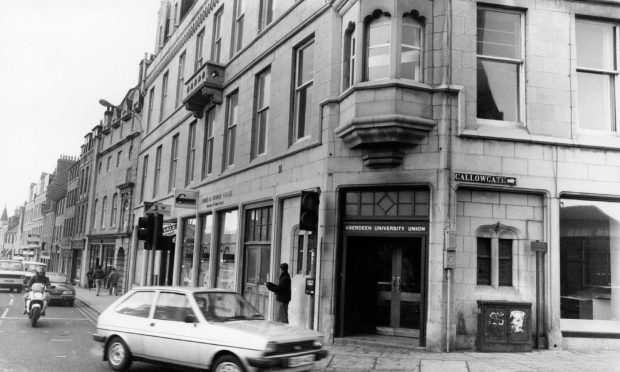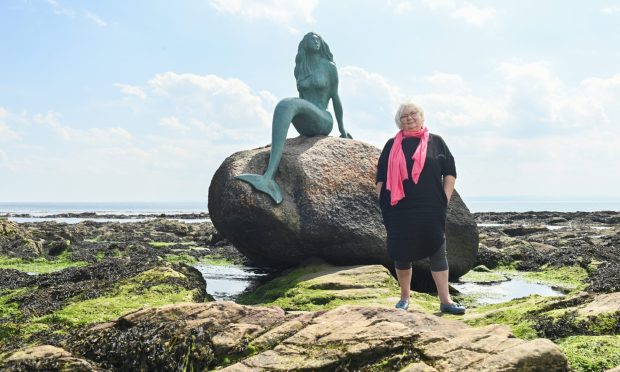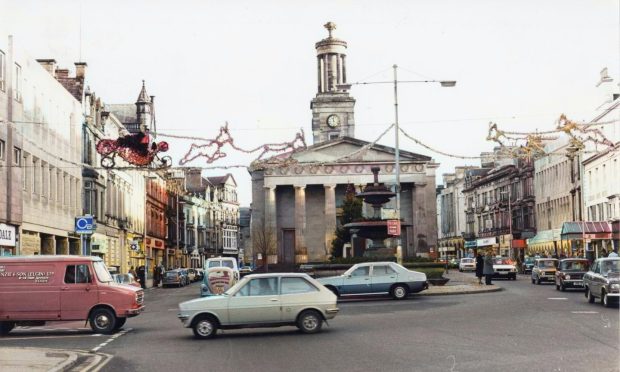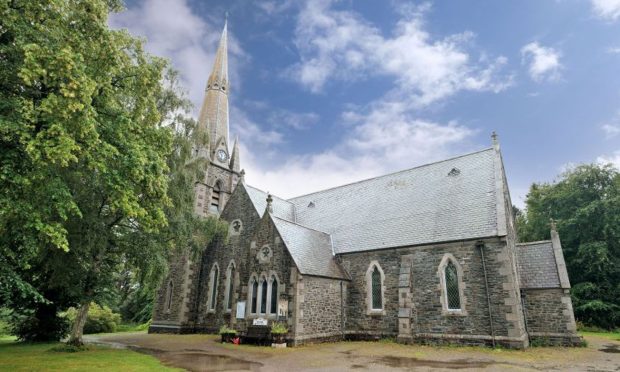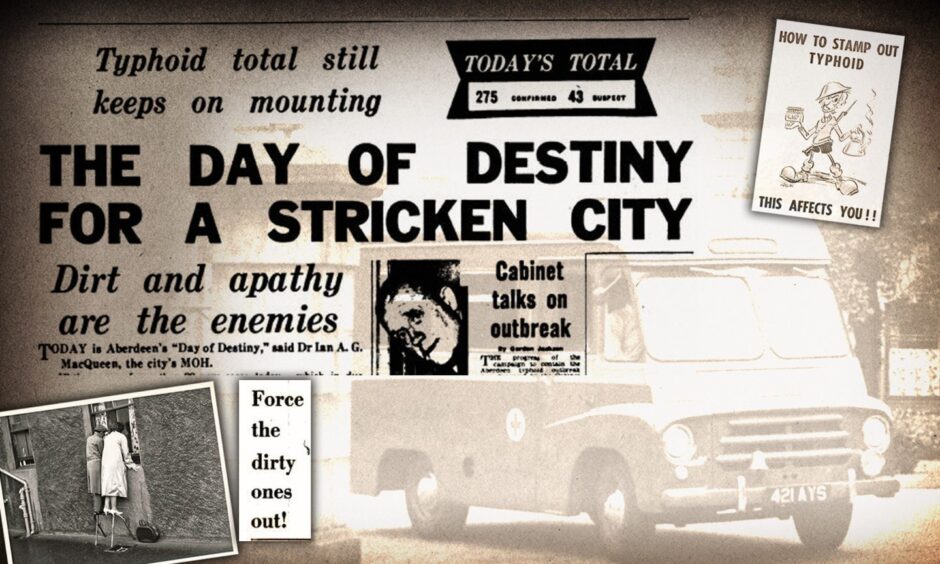
The typhoid outbreak of May 1964 in Aberdeen became notorious around the world.
It wasn’t a particularly bad outbreak in blunt terms. Three people with other underlying conditions died, more than 500 were hospitalised. There had been far more lethal disease outbreaks in the UK, and would be again as we’ve all experienced.
But because of the level of hysteria which quickly whipped up around it, it’s become one of the UK’s most talked about epidemics, growing arms and legs faster than you can say ‘sense of proportion’.
Hysteria started early
Aberdeen’s Medical Office of Health (MOH) Dr Ian MacQueen was the public face of the NHS response to the outbreak.
Some of his proclamations and advice were thought to have contributed to the hysteria which resulted in Aberdeen becoming a pariah city, holidays and events cancelled, and businesses closing.
Eventually Queen Elizabeth came north to try and restore the Granite city’s tattered reputation.
Let’s track the outbreak from its beginnings.
On Saturday May 16, two university students were admitted to Aberdeen Royal Infirmary with fever of unknown origin.
It wasn’t until Wednesday May 20 that tests revealed they had typhoid fever.
Typhoid is a serious infection caused by the bacteria Salmonella Typhi. It’s highly contagious and is spread through contaminated food or water. It can be life-threatening.
Friday May 22
14 cases, 2 suspected
On Friday May 22, 16 people found themselves in the City hospital’s fever and isolation unit, 14 with confirmed typhoid.
An epidemic loomed, and “Don’t be surprised if the number of suspects goes up quite appreciably,” warned MOH Dr MacQueen.
More than 200 contacts had been tracked down to try and prevent further cases.
At this point, the origins of the outbreak weren’t publicly known, but Dr MacQueen hinted that they had a good idea.
He said he was certain the food involved had been identified, and blood for testing had been taken from every person who could have handled it.
Typhoid was a serious disease and used to have a 20% fatality rate.
Even at this early stage, lab and nursing staff at the City Hospital were working at full stretch.
Saturday May 23
There were now 24 in hospital.
Dr MacQueen released their names and advised anyone who had had food handled by them in the previous 18 days and had not already been contacted by the health and welfare department to ‘have a word’ with the family doctors.
Estimated 400 at risk
He estimated that about 400 people might have eaten food prepared or handled by one of the cases, and were ‘at risk.’
“I am not saying are to have 400 cases or even 100 cases. There are 188,000 people in Aberdeen and another 50,000 roundabout who are no more at risk of developing typhoid than they were six months ago or will be in six months time.”
No fatalities expected in Aberdeen typhoid outbreak
One or two of the cases, he said, were quite ill, but it was not expected that there would be any fatalities.
Dr MacQueen said that he had not named the patients earlier because it might have created “an awful lot of alarm and despondency”.
“Another reason for releasing the names was that a person who was ill and who was a bit confused because of the illness could not be expected to tell, among other things, all the people who had been in their homes over a period and had food or drink in their homes.
“We want to find anybody who has been missed.”
Monday May 25
There was a press appeal for nurses to come out of retirement as the number of cases rose to 59.
The Scottish Office admitted that it amounted to a serious outbreak, “but not as serious as it would be if there was more than one source of the outbreak.”
But the public still didn’t know the source of the contamination and were getting agitated.
Too much secrecy?
One EE reader said there was far too much secrecy about it.
“If we knew we had any food from any place involved, we could take precautions and consult our doctors,” she said.
Tuesday May 26
81 cases and 9 suspected
More angry accusations of secrecy as the source of the infection remained unnamed.
The business community started to agitate, demanding answers to quell the many wild rumours regarding the cause of the outbreak.
Some firms were already losing trade.
Nurses came out of retirement
Meanwhile, fourteen retired nurses had been recruited to cope with the extra work, and 48 patients had been evacuated from the City Hospital to an unnamed Aberdeen hospital.
Schools had been asked to stress the importance of hand-washing, and using paper towels rather than roller towels.
Don’t offer sweets to your classmates!
Youngsters were warned that even unwrapped sweets and other unwrapped food were a potential danger.
Pupils were told to collect their own school meals and milk from a central distribution point and told not to assist in distributing it to their classmates.
Word of cancelled holidays and events started to filter through.
Gladys Lee, manageress of the Earl’s Court Hotel in Queen’s Road said: “We have had 17 cancellations so far, mostly from people with children. They were all coming within the next few days.
“Two other guests who arrived yesterday morning went to their doctor for inoculation before they left home.”
Wednesday May 27
108 confirmed and suspected cases
Dr MacQueen said he was worried about the sagging morale of the army of front-line troops fighting the outbreak due to a barrage of criticisms.
He doesn’t specify what the criticisms were; and he still hadn’t revealed the source of the infection.
Possibility of second wave of typhoid outbreak in Aberdeen
He said the first wave of the outbreak seemed to be dwindling, but wondered whether there was going to be a second wave, and “whether it will be smaller or larger is anybody’s guess,” he added.
“When you think of all the possibilities of people infecting others there is still a pretty grave danger.”
Plans to take 200 Aberdeen primary school children camping in Midlothian were cancelled, and another school camp in June was ‘in the balance’.
Northfield parish church Sunday school picnic for about 500 people at Drumoak that Saturday was cancelled on the advice of the authorities.
Cancellations of hotel bookings in Aberdeen continued, with two city hotels confirming that bus parties coming for the weekend had cancelled their trips.
Thursday May 28
85 cases, with 13 suspected
It looked as if the cases of primary infection were falling off.
At last it was revealed that corned beef was the source of the outbreak, but not where it had come from.
Destructive rumours circulate
One poor shop owner hit out at rumours killing the trade in her general merchant’s shop in Lang Stracht.
Dorothy Duguid had been forced to put a notice in her shop window denying rumours that she and a female assistant had typhoid.
A growing list of events had been cancelled for the Scouts, Cubs and Boys Brigades.
A Territorial army mountain rescue exercise in the Cairngorms involving 300 men was off.
Picnics cancelled
More Sunday school picnics were cancelled, and a Scottish Women’s Rural Institute meeting in the city was also cancelled.
The schools would be closed if a second wave materialised, said Dr MacQueen.
Friday May 29
113 confirmed cases, 29 suspected
Fears of a second wave intensify.
More functions, meetings and outings were cancelled, and sports fixtures in Broughty Ferry and Arbroath were also off.
Aberdeen traders, their businesses already suffering, predicted a bleak weekend ahead, estimating losses of up to 50%.
Hygiene practices improve
But one silver lining was the hike in hygiene practices. One caterer said: “Quite frankly, you are probably safer eating out in Aberdeen at the moment than anywhere else in the country. The strictest possible hygiene methods are being used scrupulously.”
A plea for temporary copy typists and domestics to help at the city hospital’s laboratory was made by Dr AH Duncan, medical superintendent.
It was a tough time for the kids, as children of typhoid suspects were shunned by other children.
War on rumour-mongers
The Evening Express waged war on ‘rumour pests’.
“There may be something you want to know. We’ll try to find the answer.
“There may be something you want to say. We welcome your viewpoint.
“But for heaven’s sake, let’s put a gag on the rumour-mongers.”
EE reporters also went around city food shops looking for poor hygiene standards, and found plenty, from grubby overalls to dirty sponges and a lack of personal cleanliness.
Saturday May 30
141 cases and 42 suspects.
A low point.
One patient had died.
Aberdeen was now a beleaguered city, with a quarter of a million people at risk, said Dr MacQueen.
He strongly advised anyone even thinking of coming to Aberdeen on holiday in the next week or two to cancel it, even if it meant having no holiday at all.
He said: “It is also desirable that people should not leave Aberdeen.”
Schools were now closed, as were youth clubs for the under-11s.
Couples were getting married but cancelling their wedding receptions.
Monday June 1
The second wave has started.
197 confirmed cases.
Dr MacQueen points the finger at sales assistants due to faulty hygiene.
The outbreak had spread to Banffshire where there were seven typhoid cases, six from Buckie and one from Aberchirder.
Shipyard workers in Greenock advised to take special precautions regarding their personal hygiene after finding out that the Aberdeen man whom they’d been working with was now in hospital in Newcastle as a typhoid suspect.
Five people in Edinburgh now under observation by public health authorities following a visit to Aberdeen.
Government corned beef stocks suspected as source of typhoid outbreak in Aberdeen
Fingers had been pointed at Government-held 14 year old stocks of corned beef as the source of the infection, but a Government statement denied this.
At Craibstone Agricultural College in Bucksburn, 70 residential students were quarantined.
A Swedish vessel lies off Aberdeen waiting for an assurance that it was safe to enter the port.
Crews of all merchant ships entering Aberdeen advised not to eat or drink on shore.
Shipowners were suggesting they would send their vessels to other ports and have the cargo conveyed to Aberdeen by rail or road.
All public drinking fountains were turned off.
Tuesday June 2
224 confirmed cases, 25 suspected
Washing facilities must now be provided on vans, after a loophole in the Food Hygiene Regulations meant there were a number of vans running about the city with no washing facilities.
Government to set up an independent inquiry to discover the cause of the Aberdeen outbreak. Still denying any connection between the outbreak and government stocks of corned beef; but their 6lb cans of bully beef are withdrawn from sale. Couples continued to cancel their wedding receptions.
Aberdonians bound for Jersey and Guernsey, and Butlin camps for their summer holidays were asked to cancel their bookings.
In Jersey and Guernsey it was the medical officers of health who made the request.
Butlins sent telegrams to 35 Aberdonians who were due to holiday at camps throughout the country from Saturday.
A Butlins spokesman in Ayr said there were several Aberdeen families in their camp at present.
“One woman is scared to reveal where she comes from in case she is treated as an outcast. However all are being extremely well treated, and no-one has even broached the subject to them.”
Thursday June 4
275 confirmed cases, 43 suspected
Dr MacQueen calls it Aberdeen’s ‘Day of Destiny.’
If there were 20 new cases, it would be a day of victory for health workers.
But if there were 25 or more, ‘dirt, carelessness, ignorance and apathy would have triumphed’.
He reasoned that most typhoid cases in the city to date had arisen before the presence of typhoid was known, so that if there was a reduction in new cases, it meant that the tide had turned and preventive measures were winning.
Typhoid used to kill 12,000 a year
“Let us remember that within the lifetime of people still alive in Britain, typhoid was the commonest of all fevers and was killing 12,000 people a year.”
He also warned Aberdonians not to go on holiday over the next fortnight, especially to centres of population like Brighton and Blackpool.
His message was blunt. “If you go out of Aberdeen the risk is fundamentally to the people you are going to visit. If you come into Aberdeen on holiday, the primary risk is to yourself.”
Gigs cancelled
Wayne Fontana and the Mindbenders cancelled their gig in Elgin, but not in Inverness with The Hollies.
The visit of the US Air Force Band to Peterhead was cancelled.
Friday June 5
292 cases, 48 suspected
Big efforts were being made in Aberdeen to get the trades fortnight put back. There seemed to be a consensus that it was the right thing to do.
The EE mounted an investigation into the wisdom of the Aberdeen Links Golf Championship going ahead the next day and came out firmly against it.
This was because the clubhouse had inadequate toilet and washing facilities, and because of the concentration of crowds of golfers therein.
We think this is madness! was their view.
Saturday June 6
324 cases, 55 suspected
‘Wee Alicky’, the popular Green Final cartoon character who followed the Dons, became the face of the fight against the spread of typhoid.
Armed with soap, nailbrush and boiling water, he dominated the cover of a 12-page public information brochure circulated round businesses and factories in the city.
Dr MacQueen said he hoped to sound the all-clear in July, but cases were still spiralling.
Monday June 8
345 cases, 67 suspected
Despite the soaring cases, the headlines were proclaiming a glimmer of hope.
Only ten more people had been taken into Aberdeen’s typhoid hospitals over the previous 24 hours, and only three more cases had been confirmed.
Dr MacQueen said he was confident that the danger of a big third wave was over.
But the outbreak was taking its toll on businesses.
Hardy & Marshall in Holburn Street had to close down, because partner John Hardy was a typhoid suspect.
And on the other side of the world, British passengers arriving in Fremantle, Australia aboard the liner Hellenis were checked by federal quarantine officers. They said the checks would continue until the typhoid outbreak subsided.
Wednesday June 10
376 cases, 55 suspected
Aberdonians were using an astonishing 1,500,000 gallons more water in a day than before the outbreak. Fortunately, the city water department said there was no danger of any water shortage.
The authorities agreed to withdraw 400 6lb cans of Argentinian corned beef from Aberdeen food shops as a precautionary measure.
Thursday June 11
387 cases, 52 suspected
A corner seemed to have been turned as admissions of new cases were going down.
But all the summer camps in the Aberdeen and North-east Scotland wing of the ATC were cancelled, and miles away from the outbreak, the 4th Kirkcaldy company of the Boys’ Brigade cancelled their summer camp in Galashiels.
Friday June 12
393 cases, 52 suspected
Because the number of cases was slowing down, it was announced Aberdeen’s 32,000 schoolchildren would return to school in a staggered fashion the following week.
There was no letup in the public health campaign, as Dr MacQueen gave a hard-hitting warning against relaxing hygiene standards in the city.
“If we let up in personal hygiene we may have typhoid for months and months to come,” he warned.
Saturday June 13
383 cases, 52 suspected
Things started getting back to normal with shoppers out in the city centre in near normal numbers, and pub trade beginning to pick up again.
The front page of the papers ceased to be dominated by the outbreak.
The tide had turned.
In the end, there were around 500 cases of typhoid, with three deaths reported to have occurred in people with other serious health conditions.
The outbreak was traced to contaminated tinned corned beef from Rosario, Argentina.
Pollution from the waters of the Uruguay River (which flows into the Río de la Plata) appeared to be the source of the contamination, probably through water entering a defective tin through a small puncture.
The meat was sold in the William Low grocery store in Holburn Street.
It contaminated their slicing machine, leading to the spread of the disease through other sliced meats.
The bacteria multiplied further in the meats as they were placed near a window and exposed to sunlight.
